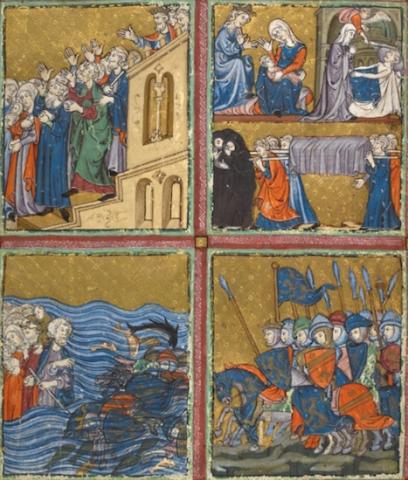The word "Pesach" is pronounced PAY-sahch, with the "ch" sounding like the "ch" in the Scottish word "loch." It stands for "Passover," a holy day (and a major celebration) in the Jewish calendar.
It commemorates when the Israelites were spared the trauma of the tenth plague to befall Egypt, during a time when Jews were slaves in that country.
Every year, on the eve of the Jewish Passover holiday, a child will ask this question during the Seder (family dinner):
Why is this night different from all other nights?
That traditional question sets-up the narrative of the Passover story, when Moses led the Jewish people out of slavery in Egypt. The story of the plight of the Jews in Egypt, and of the ten plagues, is told in the book of Exodus (the second book of the Jewish Torah and the Christian Bible).
In summary ... every time that Moses asked Pharaoh to “Let my people go!”—and Pharaoh refused—a plague descended on Egypt. The first nine plagues were:
- The Plague of Water Turned to Blood
- The Plague of Frogs
- The Plague of Bugs (Lice or gnats)
- The Plague of Flies
- The Plague on the Animals (Livestock)
- The Plague of Boils
- The Plague of Hail
- The Plague of Locusts
- The Plague of Darkness
When Pharaoh continued to refuse to let the Jews leave Egypt, Moses predicted another—even more terrible—plague if Pharaoh remained stubborn. It would be the “Plague of the Firstborn.”
What was the Plague of the Firstborn?
Moses predicted that the firstborn son of all families in Egypt would die unless Pharaoh let the Jews leave. To prevent the Jews from suffering the same result, if Pharaoh still refused, Moses told his people to paint the doorposts of their homes with the blood of a lamb. Wherever there was blood on the door, the Angel of Death would “pass over” that house, sparing the life of the firstborn son.
When Pharaoh still refused to let the Jews leave Egypt, the tenth plague plunged Egyptian homes into sadness. For Jews who had heeded the advice of Moses—to paint their doors with the blood of a lamb—the Angel of Death passed over the homes, sparing the lives of the firstborn sons inside.
Even Pharaoh was not spared this tragedy. When his firstborn son died, because the Angel of Death did not pass over Pharaoh’s home, the Egyptian Ruler finally granted the demands of Moses. He let the Jewish people go.
This video animation depicts the story of the Passover, which can be used during part of the Seder ** to answer the traditional question:
** NOTE, however, that at the very end of the animation a reference is made to Jesus which is inconsistent with Jewish beliefs.
Media Credits
Lead image, in four parts, from the "Golden Haggadah," c. 1320, northern Spain Plagues, probably Barcelona (online via the British Library, MS. 27210, fol. 14 verso). The images include "The Pharaoh and Queen Mourning Their Son," "Six Men Carrying a Firsborn's Coffin" and "The Israelites Escaping."


